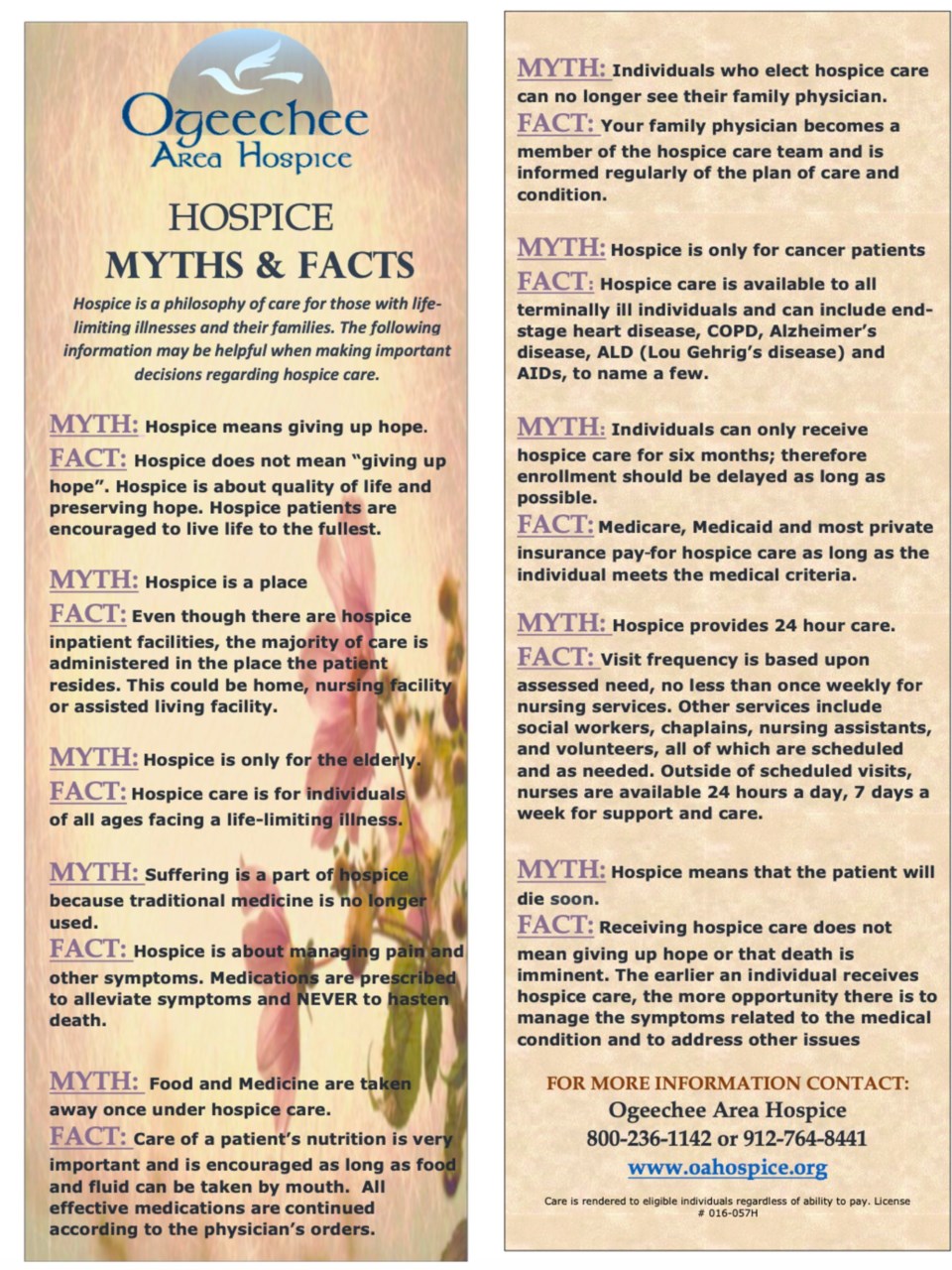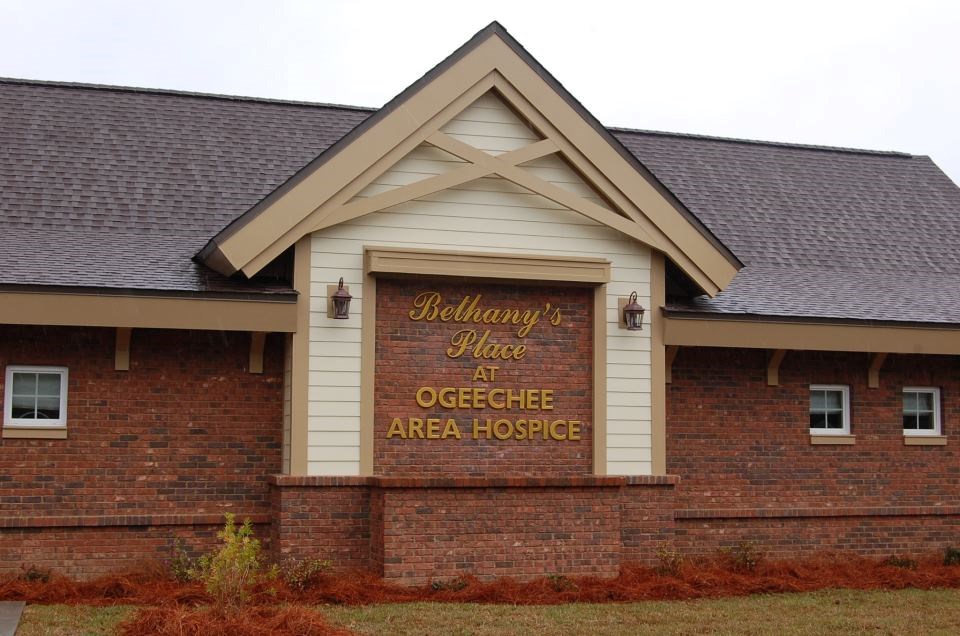The hardship of terminal illness is a struggle that many, even most, individuals and their family members will face during their lives. When you think of hospice care, comfort and dignity may come to mind, but sometimes we associate hospice with negative or false ideas.
Ogeechee Area Hospice is working to combat the myths around the specialized care that they provide, and let the community know that hospice is not a bad word. How you approach life’s final stage is important, and by helping individuals manage pain, find peace, and extend the time and quality of their life, hospice care can ease much of the suffering and anxiety a terminally ill person may face.
Hospice is a philosophy of care -- not necessarily a place. While many hospices have an inpatient care facility like OAH, the majority of care is provided at the patient’s residence, whether that be a home, nursing facility, or assisted living facility. Some patients do, however, live at OAH if they are unable to live alone or don’t have relatives that are able to help care for them.

Additionally, OAH says that hospice is not just for people with cancer or the elderly, but anyone with a terminal condition including heart disease, COPD, AIDS, Alzheimer's, or ALS, for instance.
Cissy Daniel, an OAH social worker, says the belief in this myth unfortunately means many people often don’t introduce hospice care or wait longer than they have to, because they don’t know that they qualify.
This issue compounds with the common misunderstanding that a doctor has to initiate hospice, and that an individual must choose the hospice service the doctor suggests. Tinker Lanier, donor relations/facility and marketing manager for OAH, clarifies that a patient or their family can directly inquire about hospice care and find out if they meet the criteria, which are then confirmed through a doctor's orders.
Once a person is qualified, a nurse evaluates and determines the amount of care a person will need, which the medical director then approves. Each patient is assisted through their care with the help of an interdisciplinary team consisting of nurses, social workers, chaplains, aides, and the OAH Medical Director Dr. Angela Gerguis.
“We all see it through our lens and then we bring all of those lenses together and talk about the patient and fill in the gaps,” says Daniel, whose work includes performing psychosocial assessments.
“That's just to basically look at the family system and see what we can do to plug any holes. Like if they don't have enough care, or if they have an elderly caregiver that needs some support, or if there are some family dynamics that we can help with,” Daniel said.
This team takes over a person's care and allows them to forgo the often stressful hospital and emergency room settings. The patient can receive all of their medical care at home or in the facility, and Daniel assures that family physicians can remain involved with treatment.
This care is not just medical treatment for the patient, but a tool for people and their families to navigate the difficulties of the diseases they face and their eventual passing.

Counseling is a big part of the services provided at OAH, which often include a faith-driven approach with the help of chaplains that guide patients through processes of making peace with difficult spiritual afflictions.
“It's been proven over and over that people who have a spiritual anchor of some kind, do much better at the end of life,” said Daniel.
While hospice helps to provide the essential management of a patient's symptoms, Daniel says, “Emotional pain can be just as hard as physical pain.”
She says many of the patients at OAH observe a Christian faith, but people of all spiritualities can find comfort while receiving care. “We have a beautiful chapel here, with a beautiful stained glass window, and we say you can look at that stained glass window in any way you want to,” said Lanier.

The care teams work to provide patients with whatever they need to work through what they call "pending," or unfinished, business. Such difficulties as reconnecting them with estranged children, working with the Red Cross to bring distant military relatives back in time to visit, or setting up video calls to connect family and friends that are too far to be with the patient before their passing.
Sometimes, for inpatients, this includes bringing in their beloved pets to be with them in their final days. The OAH workers say the patients even have the chance to spend time with therapy dogs, which many of those folks benefit from.
The families are cared for in many ways too, with hospice programs offering respite, which provides relief to caregivers by taking patients into facilities for nursing over the period of a few days. And after the passing of a family member, OAH provides bereavement services for 13 months to help people get through the often most difficult first year of losing someone.
But even beyond that time, they can attend the community memorial events hosted by OAH, that help people remember their loved ones in the support of other families that have gone through similar experiences.
Daniel says that the holidays are usually the most difficult times for the families in mourning, and it can be a danger not to prepare for the first celebrations without a family member. OAH events like the Mistletoe and Memory Tree Lighting Ceremony can help families incorporate the loved ones they are still grieving, in ways that allow them to remember them while also learning how to enjoy these times after their loss.
They say that it takes a personal calling to be able to work in hospice. Daniel and Lanier’s own experiences of losing loved ones in hospice care brought them to and strengthened their beliefs in the philosophies of hospice.
And while we aren't all made for working in hospice, most people know the pain of grief, and the blessing that a peaceful, dignified death is to a person and their family. So we can all appreciate the importance of the care at OAH.

Ogeechee Area Hospice is a non-profit organization, whose $7.1 million dollar specialized care facility’s construction was funded through the generous donations of individuals and businesses in Bulloch County and the surrounding community. Lanier says that each patient's care is funded through personal insurance, Medicare or Medicaid that OAH can help them get. No matter what, they never deny hospice service.
It's the dedication of individuals like Lanier, Daniel, and the rest of the OAH team that help bring comfort to the people with life-limiting conditions, and support to their families while facing life’s final transition.
Read the pamphlet below for more information about myths you might believe about hospice, and the facts that you should know.





